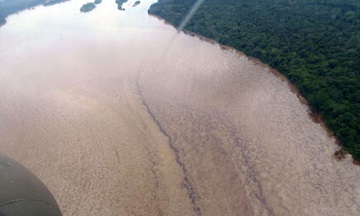Ecuadorean Amazon oil slick heads towards Peru
An oil spill in the Ecuadorean Amazon is flowing downstream towards Peru and Brazil, heightening concerns about the impact of drilling in one of the world’s last remaining wildernesses.
 About 1.6m litres of crude was discharged into a tributary of the Amazon from the Trans-Ecuador pipeline, which was ruptured by a landslide on 31 May.
About 1.6m litres of crude was discharged into a tributary of the Amazon from the Trans-Ecuador pipeline, which was ruptured by a landslide on 31 May.
The slick contaminated the drinking supplies of Coca, a gateway city into the Amazon forest. Local media reported that 60,000 people had to rely on water brought in by 65 tankers.
Petroecuador, the pipeline operator, has hired the US clearup company Clean Caribbean & Americas, which was involved in the operation after the Gulf of Mexico spill.
Although the company and local authorities tried to contain the slick with a boom, some of the oil entered the Napo river, which flows across the border.
Last week Peru reported traces of the oil in its Amazon region of Loreto, prompting an apology from the Ecuadorean president, Rafael Correa.
The Peruvian environment minister, Manuel Pulgar Vidal, described the slick as a “very serious problem” and said Peru could seek compensation if the damage proved extensive.
Brazil, which is located many hundreds of miles downstream, has put its navy on alert and offered technical assistance.
“Brazil has offered aid to Ecuador and Peru to support the work of containment and dispersion of the oil slick in the two countries,” the foreign ministry said in a statement.
The environment of Ecuador, the smallest member of Opec, the Organisation of the Petroleum Exporting Countries, has long suffered from the oil industry. In 2011 the country’s courts ruled that the US oil firm Chevron should pay $8.6bn in compensation for the dumping of about 7bn litres of waste over several decades.
The latest slick is not large by comparison, but it comes at a sensitive time in an area of immense ecological wealth. With the oil fields now largely owned and operated by domestic state-run companies, the government plans to ramp up production in the Amazon to fund an ambitious development programme and repay loans from China. Its plans have been opposed by indigenous groups and environmental campaigners.
 About 1.6m litres of crude was discharged into a tributary of the Amazon from the Trans-Ecuador pipeline, which was ruptured by a landslide on 31 May.
About 1.6m litres of crude was discharged into a tributary of the Amazon from the Trans-Ecuador pipeline, which was ruptured by a landslide on 31 May.The slick contaminated the drinking supplies of Coca, a gateway city into the Amazon forest. Local media reported that 60,000 people had to rely on water brought in by 65 tankers.
Petroecuador, the pipeline operator, has hired the US clearup company Clean Caribbean & Americas, which was involved in the operation after the Gulf of Mexico spill.
Although the company and local authorities tried to contain the slick with a boom, some of the oil entered the Napo river, which flows across the border.
Last week Peru reported traces of the oil in its Amazon region of Loreto, prompting an apology from the Ecuadorean president, Rafael Correa.
The Peruvian environment minister, Manuel Pulgar Vidal, described the slick as a “very serious problem” and said Peru could seek compensation if the damage proved extensive.
Brazil, which is located many hundreds of miles downstream, has put its navy on alert and offered technical assistance.
“Brazil has offered aid to Ecuador and Peru to support the work of containment and dispersion of the oil slick in the two countries,” the foreign ministry said in a statement.
The environment of Ecuador, the smallest member of Opec, the Organisation of the Petroleum Exporting Countries, has long suffered from the oil industry. In 2011 the country’s courts ruled that the US oil firm Chevron should pay $8.6bn in compensation for the dumping of about 7bn litres of waste over several decades.
The latest slick is not large by comparison, but it comes at a sensitive time in an area of immense ecological wealth. With the oil fields now largely owned and operated by domestic state-run companies, the government plans to ramp up production in the Amazon to fund an ambitious development programme and repay loans from China. Its plans have been opposed by indigenous groups and environmental campaigners.
You can return to the main Market News page, or press the Back button on your browser.

